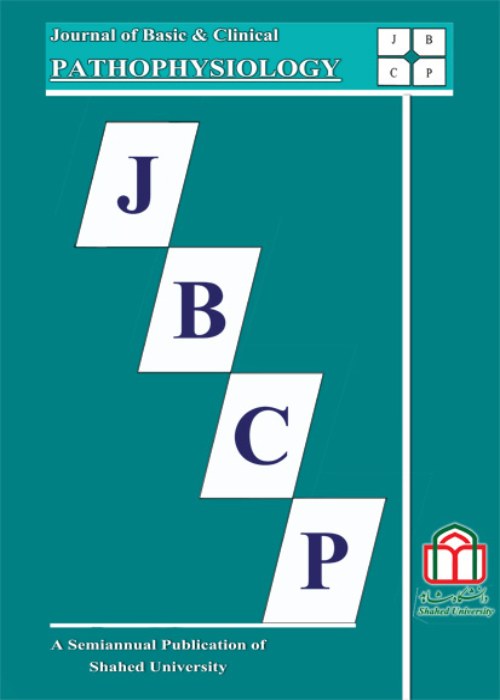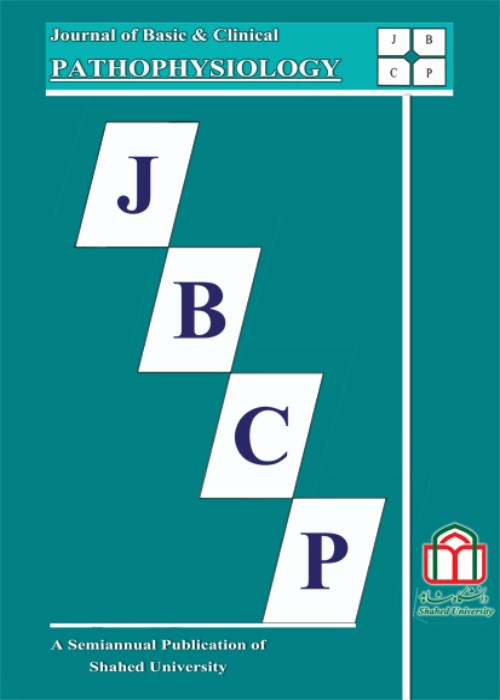فهرست مطالب

Journal of Basic & Clinical Pathophysiology
Volume:10 Issue: 2, Summer-Autumn 2022
- تاریخ انتشار: 1401/09/10
- تعداد عناوین: 6
-
-
Pages 1-8Background and ObjectiveAcinetobacter baumannii is a serious challenge to the healthcare system as a multi-drug-resistant bacterium. BauA is a siderophore of A. baumannii. Oma87 has been stated as an immunogenic outer membrane protein per reverse vaccinology. Biofilm-associated protein (Bap) plays an indispensable role in biofilm formation by this pathogen and makes it resistant to a wide range of antibiotics and lethal conditions. The persistence and colonization of A. baumannii can be prevented by raising antibodies against BauA, Oma87, and Bap.Materials and MethodsThe recombinant proteins BauA, Oma87, and Bap were expressed and purified and injected subcutaneously in single and/or in combination forms to BALB/c mice and then they were challenged intraperitoneally with a lethal dose of 50% A. baumannii ATCC19606. The serum of combined mice was injected intravenously through the tail vein to create passive immunity in non-immune healthy mice. The mice's spleen, liver, and lung tissues were examined to check the bacterial load.ResultsOma87 and Bap in combination with BauA in the mouse model brought about significant immunity. Antibodies produced in mice successfully detected and bound the combination of antigens in the mouse model. After immunizing and challenging mice with Acinetobacter baumannii ATCC19606 admixed with mucin 100%, the survival rate was monitored. Passive immunization using the sera of mice immunized against Oma87 and BauA as well as BauA and Bap yielded 85.7% survival.ConclusionThe combination of BauA with Oma87 and Bap brought about higher protectivity against A. baumannii infection than their individual administration.Keywords: A. baumannii, BauA, Bap, Oma87, Immunogen
-
Pages 9-17ObjectiveWe investigated the effect of a high-calorie high-salt diet and sprint interval training on oxidant/antioxidant status and structural changes in the spleen of male Wistar rats.Materials and MethodsEighteen male Wistar rats were randomized into three groups: normal diet (ND), high-calorie high-salt diet (HCSD), and HCSD + sprint interval training (HCSD+SIT). Rats in HCSD and HCSD+SIT groups were under a high-calorie high-salt diet. The SIT (4-9 reps of 10 s duration sprints) performed 3 sessions/week for 8 weeks. Forty-eight hours after the last training session, spleen was removed and used for the assessment of oxidant/antioxidant status and histomorphometric parameters.ResultsResults revealed that compared to the ND group, superoxide dismutase (SOD) activity, glutathione peroxidase (GPx) level, and total antioxidant capacity (TAC) were significantly lower (P<0.001) and malondialdehyde (MDA) level was significantly higher in the spleen tissue of the HCSD group (P<0.001) and there was no significant difference between the HCSD+SIT and ND groups in none of the assessed variables (P>0.05). Moreover, there was a significant increase in the red to white pulp ratio and a significant decrease in the number of lymph cells and splenic trabecular volume in the HCSD group (P<0.001). Nonetheless, in none of the assessed morphometric parameters, a significant difference was observed between the HCSD+SIT and ND groups (P>0.05).ConclusionIt seems that SIT training may avert HCSD-induced unfavourable changes in the spleen oxidant/antioxidant status and counteract the deleterious effects of the HCSD on the spleen structure.Keywords: High-fat diet, High-sugar diet, High-salt diet, High-Intensity interval training, Spleen
-
Pages 18-23Background and ObjectiveLiver disorders are associated with high rate of morbidity and mortality. Carbon tetrachloride (CCL4)-instigated model of ALI is a valid model for exploring liver damage. Licochalcone A is a bioflavonoid which is primarily isolated from roots of Glycyrrhiza species. In this study, the effect of this flavonoid in CCl4 mouse model of acute liver injury (ALI) was assessed.Materials and MethodsFor induction of ALI, CCl4 (10 ml/kg body weight, 0.175% in olive oil) was intraperitoneally injected and licochalcone A was orally administered at doses of 10 or 50 mg/kg. Functional markers of liver dysfunction were determined in addition to hepatic analysis of oxidative stress and inflammatory factors.ResultsLicochalcone A pretreatment at a dose of 50 mg/kg significantly and notably decreased level of alanine aminotransferase (ALT), aspartate aminotransferase (AST), malondialdehyde (MDA), reactive oxygen species (ROS), tumor necrosis factor-α (TNF-α), interleukin 6 (IL-6), and myeloperoxidase (MPO) and significantly improved total antioxidant capacity (TAC) and superoxide dismutase (SOD) activity and with no significant effect on interleukin-1β (IL-1β). In addition, these beneficial effects were not obtained for licochalcone A at a dose of 10 mg/kg in CCL4-injured group.ConclusionThese findings show beneficial property of licochalcone A following CCL4-induced liver injury that is exerted via its regulation of oxidative and inflammatory processes and upregulating antioxidant power.Keywords: Acute liver injury, Hepatotoxicity, Carbon tetrachloride, Licochalcone A, Oxidative stress, Inflammation
-
Pages 24-29ObjectivePiracetam and octreotide as nootropic and neuroprotective medicines were used in the epileptic rats to evaluate their impacts on the hippocampal expression of BAX and BCL2 genes.Materials and MethodsSix experimental groups of adult rats were pretreated for 7 days as follows: two piracetam groups (30 and 100 mg/kg/day), two octreotide groups (50 and 100 mg/kg/day), positive control group (injected with diazepam, 2 mg/kg, single dose before pentylenetetrazole injection) and negative control group (injected with normal saline). Seizures were induced with a single injection of pentylenetetrazole (PTZ, 60 mg/kg) after pretreatments. Signs of resulted seizures were classified according to the Racine scale. The BAX and BCL2 transcripts were measured in the hippocampus by quantitative real-time PCR.ResultsA delayed onset time of the seizures (stage 1 of Racine scale) and shorter time of the tonic-clonic seizures (stage 5 of Racine's scale) were observed in the piracetam and octreotide groups as compared to negative control group (P<0.05). The BAX transcript was higher in the positive control and octreotide (100 mg/kg) groups than other groups (P<0.05). The BCL2 transcript was higher in the positive control, piracetam (100 mg/kg) and octreotide (100 mg/kg) groups than the negative control group (P<0.05). The BAX/BCL2 ratio was lower in the positive control and piracetam (30 and 100 mg/kg) groups than other groups (P<0.05).ConclusionBAX/BCl2 ratio as an indicator of progressive apoptosis was attenuated by the piracetam in the hippocampus of epileptic rats while useful effects of the octreotide are independent of BAX/BCl2.Keywords: Apoptosis, Gene expression, Pentylenetetrazole, Seizure
-
Pages 30-35Background and ObjectiveKidney diseases are endangering conditions to public health. Carbon tetrachloride (CCL4)-induced model of acute kidney injury (AKI) is a reliable model for studying renal damage under different conditions. S-allyl cysteine (SAC) is a natural organosulfur compound in aged garlic extract with multiple protective effects. In this study, possible preventive effect of SAC in CCl4 model of AKI was investigated.Materials and MethodsFor induction of AKI, CCl4 (10 ml/kg body weight; 0.175% in olive oil) was intraperitoneally injected and SAC was given orally at doses of 25 or 100 mg/kg. Functional markers of kidney were determined besides renal analysis of oxidative stress and inflammatory indices.ResultsSAC pretreatment at a dose of 100 mg/kg for 1 week before CCL4 challenge significantly and markedly reduced level of blood urea nitrogen (BUN), malondialdehyde (MDA), reactive oxygen species (ROS), tumor necrosis factor-α (TNF-α), interleukin 6 (IL-6), and significantly enhanced superoxide dismutase (SOD) activity and with no significant effect on creatinine and catalase activity. In addition, such valuable effects were not observed for SAC at a dose of 25 mg/kg in CCL4-exposed group.ConclusionFindings of this study indicated beneficial effect of SAC subsequent to CCL4-induced kidney injury that is partly mediated through its regulation of oxidative and inflammatory events and upregulating some of the antioxidants.Keywords: Acute kidney injury, Carbon tetrachloride, S-allyl cysteine, Inflammation, Oxidative stress
-
Pages 36-40Background and ObjectiveThymoquinone stimulates the activity of hypothalamic-pituitary-gonadal axis (HPG). Diabetes, ghrelin and aromatase are associated with decreased function of HPG axis. This study aimed to investigate the influence of thymoquinone on aromatase and ghrelin gene expression in intact and diabetic rats.Materials and MethodsTwenty male Wistar rats weighing 190-220 g were used. Diabetes type 1 was induced by alloxan. Saline or thymoquinone (10 mg/kg) was injected into intact or diabetic rats intraperitoneally for two weeks. One day after last injection, the hypothalamic samples were removed. Relative gene expression of aromatase and ghrelin was determined by RT-PCR method.ResultsThymoquinone did not alter the aromatase expressions in the healthy rats. However, it caused a marked decrease in ghrelin expression in healthy rats. The aromatase and ghrelin expression significantly reduced in the diabetic rats receiving thymoquinone in comparison with diabetic group.ConclusionThymoquinone may be a drug to improve decreased HPG axis activity of diabetic rats due to its inhibitory effects on aromatase and ghrelin upstream GnRH neurons.Keywords: Thymoquinone, Diabetes, Alloxan, Aromatase, Ghrelin


